The Imperial Palace
The Imperial Palace
| Photo | Description |
|---|---|
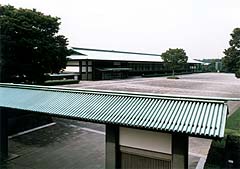 |
Nakamon-Gate and Toutei (East plaza)
The picture shows the Chowa-Den viewed from the Nakamon-gate, the places that must be familiar because of the Visits of the General Public to the Palace for the New Year Greeting held on January 2nd and for His Majesty's birthday held on February 23rd. The Chowa-Den is an establishment that measures 163m approximately, and is constituted Minami-kurumayose (South Porch), Minami-damari (South Entrance Hall), Nami-no-Ma (Lobby), Matsukaze-no-Ma (Drawing Room), Shunju-no-Ma (Grand Hall), Shakkyo-no-Ma (Drawing Room), Kita-no-Ma (Lobby), Kita-damari (North Entrance Hall) and Kita-kurumayose (North Porch), from south to north. His Majesty the Emperor makes appearance in the balcony at the centre of the Chowa-Den, accompanied by Her Majesty the Empress and other Imperial Family members, receives the cerebrations from the well-wishers, and delivers an address, on New Year Greetings and His Majesty's Birthdays every year. |
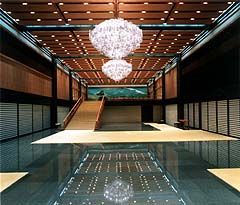 |
Minami-Damari
Minami-damari is a lobby that has an area of 528 square metres (about 160 tsubo), and are built with black granite (Matsuba-ishi) from Yamaguchi prefecture, pine wood (Hyuga-matsu) from Miyazaki prefecture, and marble (Katsuren) from Okinawa prefecture. The two chandeliers installed on the ceiling illuminate the room with light-purple beams, which are respectively made of 3,485 crystal glasses, weight 2.3 tons, are 3 metres in diameter, is 2.14 metres in height. |
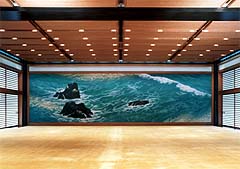 |
Nami-no-Ma
The room has an area of 248 square metres (about 75 tsubo), and is made of cedar wood (Ichifusa-sugi) from Kumamoto prefecture and pine wood from Shizuoka prefecture, etc. The painting shown in the picture is titled Dawn Tide (Asaake no Ushio), drawn by Kaii Higashiyama. The painting is said to have been modelled on the rocks of the Oumi Island in Yamaguchi prefecture, and is approximately 3.8 metres in height, approximately 14.3 metres horizontally. |
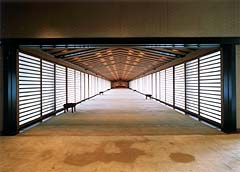 |
Kairo (Corridor)
With 6.6 metres in width and 74 metres long, the corridor is used to go from the Chowa-den which has the South Porch of the palace to the Minami-watari in Seiden (State Hall). When state guests visit Japan, Their Majesties the Emperor and Empress walks on the corridor with the guest to the Take-no-ma in Seiden where meeting is held. |
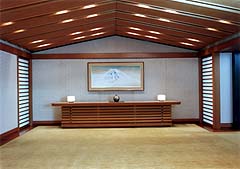 |
Walls of Kairo
Paintings are displayed on the corridor walls according to the season. On new year, on His Majesty's birthday and when state guests visit the palace, “fuji” drawn by Togyu Okumura is displayed, accompanied with “Ryusui-mon gin tsubo” created by Shiro Naito, or “Wasansou” created by Yoshiyuki Chosa. |
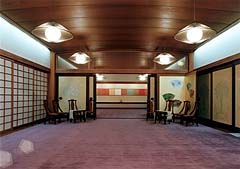 |
Chigusa Chidori-no-Ma (Drawing Room)
While Chigusa Chidori-no-Ma is constituted two rooms: Chigusa-no-Ma that has an area of 66 square metres (about 20 tsubo) and Chidori-no-Ma that has an area of 85 square metres (about 26 tsubo), they are usually used as one room. Pine woods from Kanagawa prefecture and cedar wood (Kasuga-sugi) from Nara prefecture are used to build the room. The room has a curved ceiling made of Kasuga-sugi. |
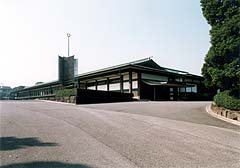 |
Kita-Kurumayose (North Porch) and Matsu-no-Tou Kita-Kurumayose is an entrance that domestic dignitaries use to enter the Imperial Palace. |
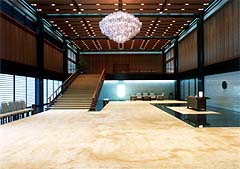 |
Kita-Damari (North Entrance Hall)
Kita-Damari is a lobby that has an area of 375 square metres (about 113 tsubo). It’s made of black granite (Matsuba-ishi) from Yamaguchi prefecture, cedar wood (Ichifusa-sugi) from Kumamoto prefecture, pine wood (Hyuga-matsu) from Miyazaki prefecture, and marble (Katsuren) from Okinawa prefecture, etc. In this lobby has the reception desk where domestic and international dignitaries sign the register book to meet Their Majesties the Emperor and Empress. On the wall behind the reception desk decorates a mural decoration of cloisonne work whose diameter is 60cm, representing “Shippou Juuniryo kyo” a Shosoin treasure (with diameter of 18cm approximately). |
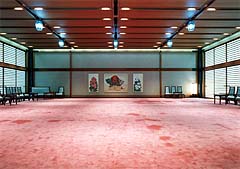 |
Shakkyo-no-Ma (Drawing Room)
Shakkyo-no-Ma has an area of 245 square metres (about 74 tsubo), and is made mainly of cedar wood (Ichifusa-sugi) from Kumamoto prefecture and pine wood (Hyuga-matsu) from Miyazaki prefecture. At the centre of the wall of the room, paintings titled “Shakkyo” “Shiro-botan” “Beni-botan” drawn by Seison Maeda are decorated. |
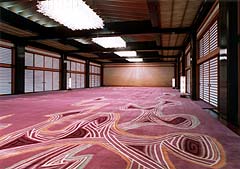 |
Shunju-no-Ma (Grand Hall)
Shunju-no-Ma has an area of 608 square metres (about 184 tsubo), and is the second largest hall in The Imperial Palace. The hall is made of cedar wood (Yoshino-sugi) from Nara prefecture and pine wood (Hyuga-matsu) from Miyazaki prefecture. Tapestry works of pine trees near Lake Biwa in the spring haze (titled ”Seikou”) and cedar trees (Kitayama-sugi) in autumn fog (titled ”Jakkou”) cover the walls on both sides of the hall, therefore, the hall is named ”Shunju-no-Ma” that means ”hall of Spring and autumn”. The stylized pattern of “kumo (clouds)” by Yasushi Sugiyama is used on the carpet on the floor. |
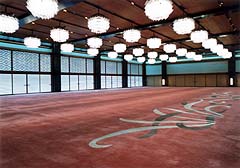 |
Houmei-Den (State Banquet Hall)
Houmei-Den is a hall that has an area of 915 square metres (about 280 tsubo), and is the largest hall in the Imperial Palace. The hall is said to have been named after a court banquet called “Toyo-no-akari-no-sechie”. The kanji “hou” as in Houmei-Den is alternatively read as “toyo”, and “mei” is alternatively read “akari”. As the decorations of the wall, the tapestry works of “Toyohata-gumo (A Pretty Bank of Clouds)” originally designed by Gakuryo Nakamura. The stylized pattern of “kusa (grass)” by Yasushi Sugiyama is used on the carpet on the floor. |
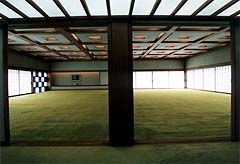 |
Rensui (Dining Room)
Rensui is a hall that has an area of 371 square metres (about 112 tsubo). There is a movable partition wall at the centre of the hall so as to divide the hall to use as two rooms for various purposes. The hall is made of pine woods from Miyazaki prefecture and Kanagawa prefecture. Rensui has a four-rowed lattice window that is modelled after the sliding doors of the Ichi-no-Ma of Shokin-Tei in the Katsura Imperial Villa, which are checkered in white and dark blue. |
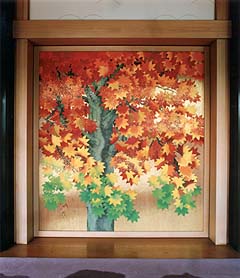 |
Seiden-Sugitoe “Kaede” - Painting on the cedar door of the east corridor of Seiden
“Kaede (maples)” drawn by Houshun Yamaguchi. It's approximately 2.74 metres vertically, 2.5 metres horizontally. |
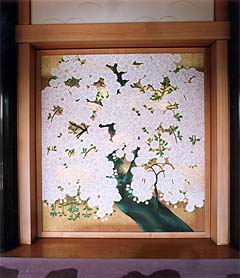 |
Seiden-Sugitoe “Sakura” - Painting on the cedar door of the east corridor of Seiden
“Sakura (cherry)” drawn by Meiji Hashimoto. It's approximately 2.74 metres vertically, 2.5 metres horizontally. |
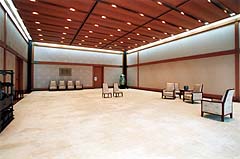 |
Take-no-Ma (Audience Room)
Take-no-Ma is a hall that has an area of 182 square metres (about 55 tsubo). The hall is made solely of cypress (Kiso-hinoki). The walls are coated with fabric that has bamboo patterns. The doorknob bases that are 52cm in diameter are decorated with “raden” by Tatsuaki Kuroda, where shell or pieces of precious metals are set. The one on the inner side has pearl oysters from Japan, and the one on the outer side has Mexican shells. In the hall, “Take (bamboo)” drawn by Heihachiro Fukuda, “Midoriji kinrande kazari tsubo” (1.53m in height) by Hajime Kato are decorated. |
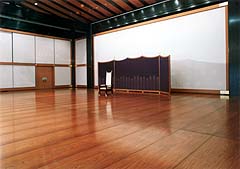 |
Matsu-no-Ma (State Room)
Matsu-no-Ma is a hall that has an area of 370 square metres (about 112 tsubo). It’s an only hall in the Imperial Palace that has a wooden floor. 87 zelkova boards of 80cm of width, 4.5cm of thickness and 5.4m of length are aligned. The walls are coated with fabric that has wakamatsu (young pine) leaf pattern. As the Matsu-no-Ma is regarded as the most elegant hall, Imperial Investitures of the Prime Minister and the Chief Justice of the Supreme Court, Ceremony of Presentation of Credentials, Ceremony of Imperial Conferment of Decoration are held here. The ceremonies are broadcasted to public by the broadcasting rooms made on the walls on both sides. |
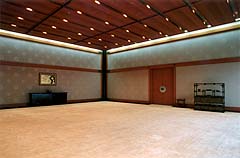 |
Ume-no-Ma (Audience Room)
Ume-no-Ma is a hall that has an area of 152 square metres (about 46 tsubo). While it’s a little smaller than Take-no-Ma, similar to Take-no-Ma, it’s made of cypress (Kiso-hinoki), and has raden decorations on the doorknobs. “Kouhaku-bai” drawn by Gakuryo Nakamura is decorated at the centre of the wall. On the big japanese-lacquered zelkova shelf, “kingin-sai kazari tsubo” by Kenkichi Tomimoto is decorated. |